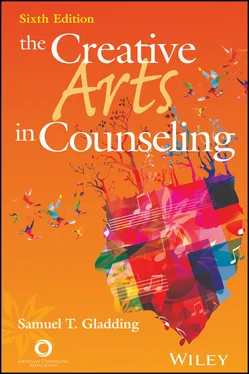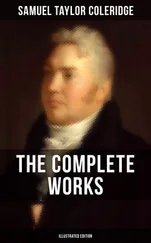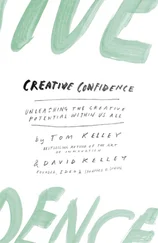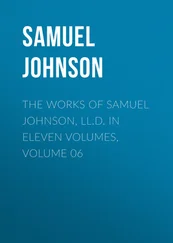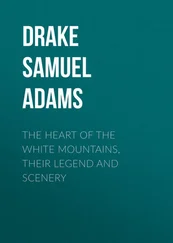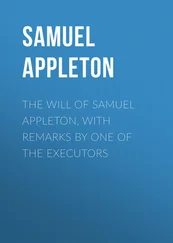Samuel T. Gladding - The Creative Arts in Counseling
Здесь есть возможность читать онлайн «Samuel T. Gladding - The Creative Arts in Counseling» — ознакомительный отрывок электронной книги совершенно бесплатно, а после прочтения отрывка купить полную версию. В некоторых случаях можно слушать аудио, скачать через торрент в формате fb2 и присутствует краткое содержание. Жанр: unrecognised, на английском языке. Описание произведения, (предисловие) а так же отзывы посетителей доступны на портале библиотеки ЛибКат.
- Название:The Creative Arts in Counseling
- Автор:
- Жанр:
- Год:неизвестен
- ISBN:нет данных
- Рейтинг книги:3 / 5. Голосов: 1
-
Избранное:Добавить в избранное
- Отзывы:
-
Ваша оценка:
- 60
- 1
- 2
- 3
- 4
- 5
The Creative Arts in Counseling: краткое содержание, описание и аннотация
Предлагаем к чтению аннотацию, описание, краткое содержание или предисловие (зависит от того, что написал сам автор книги «The Creative Arts in Counseling»). Если вы не нашли необходимую информацию о книге — напишите в комментариях, мы постараемся отыскать её.
*To purchase print copies, please visit the ACA website here
*Reproduction requests for material from books published by ACA should be directed to permissions@counseling.org
The Creative Arts in Counseling — читать онлайн ознакомительный отрывок
Ниже представлен текст книги, разбитый по страницам. Система сохранения места последней прочитанной страницы, позволяет с удобством читать онлайн бесплатно книгу «The Creative Arts in Counseling», без необходимости каждый раз заново искать на чём Вы остановились. Поставьте закладку, и сможете в любой момент перейти на страницу, на которой закончили чтение.
Интервал:
Закладка:
3 It is directed or supervised by specially trained personnel.
4 It is received by clients from newborns to geriatrics.
5 It is focused on achieving definite therapeutic goals (e.g., physical, psychological, cognitive, or social goals).
In music therapy, clients improve their level of musical functioning while simultaneously accomplishing objectives related to new or improved behaviors in the areas of motor skills, academics, communication, social interactions, or emotions (Giordano et al., 2020). The number of musically related activities (e.g., singing, playing in a rhythm band, playing Name That Tune) that can be used to accomplish these goals is extensive. A main task for the music therapist is to be versatile and creative (Memory, 2002). Therefore, music therapists must be fluent and expressive in the language of music. Peters (2001) noted, “Technical musical skills needed by the music therapist include keyboard, guitar, and vocal skills; the ability to arrange, compose, and improvise simple songs and accompaniments; [and] proficiency in playing a variety of melodic and percussive nonsymphonic instruments and conducting skills” (p. 12). Overall, music therapists must be specialists in music and human behavior but must be generalists in their ability to apply this knowledge in various situations (Michel & Pinson, 2013). They must also be imaginative, intuitive, improvising, and intellectual (Bunt & Hoskyns, 2002).
According to Hadley et al. (2001), music therapists do some or all of the following:
Assess emotional well-being, physical health, social functioning, communication abilities, and cognitive skills through musical responses
Design music sessions for individuals and groups based on client needs using music improvisation, receptive music listening, song writing, lyric discussion, music and imagery, music performance, and learning through music
Participate in interdisciplinary treatment planning, ongoing evaluation, and follow-up
To become professional music therapists, individuals graduate from specifically designed college programs with a minimum of a bachelor of music in music therapy. Educational standards are established and approved by AMTA, which is the integrated organization formed from its predecessors, the National Association for Music Therapy and the American Association for Music Therapy. For a person to become a music therapist, AMTA requires successful completion of a specific number of coursework hours as well as supervised internships in approved programs of study.
Music in Counseling
Counseling that includes music in its overall structure is not nearly as encompassing or direct as music therapy, but it involves activities such as listening, performing, improvising, and composing that are beneficial for clients. Each activity has a population that profits from its use.
Listening to musical sounds in a deep and appreciative way is an art and a skill (Sackett & Edwards, 2020; Zorn, 2007). Such listening helps individuals relax and learn and directs their attention away from life stressors. Listening to music can help clients alter their mood by reducing their anxiety, arousing their emotions, reducing pain, improving sleep quality, and inducing a relaxation response without the use of medication (Giordano et al., 2020). Listening also promotes the process of making music out of life and understanding more fully the rhythm and lyrics of songs. The latter is sometimes referred to as audiotherapy (Lazarus, 2000). An interesting and effective way of listening to music is an intervention called Mindful Music Listening , during which clients with depression use mindfulness skills while listening to music to notice, label, discuss, and learn to manage their emotions. Possible advantages include greater client self-awareness and emotional regulation as well as a stronger counselor-client relationship (Eckhardt & Dinsmore, 2012).
According to Hindu tradition, listening can occur on four levels. “The first is the level of meaning. The second is the level of feeling. . . . The third is an intense and constant awareness or presence, and the fourth is known as the ‘soundless sound’” (Beaulieu, 1987, p. 13). Each of these levels is self-explanatory, except for soundless sound. It is really the rhythmic, punctual moments of silence within a composition of sound that make the work predictable, safe, and enjoyable (Bonny, 1987). Listening also holds the power to stir up emotions in the unconscious. Song selection by clients is a kind of projective technique that reveals the needs of the unconscious for certain types of stimuli (Brodsky & Niedorf, 1986). By tracking the theme and tempo of music chosen, therapists can ascertain more clearly the emotional level at which clients are operating and thereby plan effective treatment interventions. They can also understand more readily what unique musical prescriptions, if any, might work for their clients.
One way for counselors to help clients listen more intensely to music is to play clips of music, have the individuals listen, and then help the listeners process the feelings or memories the music elicits. Another way for clients to listen to music is to ask them to bring in music on their cell phones that reflects their emotional states. In this method, clients may be asked what part of the music speaks to them most; for example, the rhythm, the melody, the lyrics (if there are any), or some combination of the three. Yet another way counselors can help clients listen to music meaningfully is to have the clients visualize a color that goes with the music the counselor selects and then talk about the experience, draw, or even move to show what they got out of the exercise. Bradley et al. (2008) have used songs with lyrics such as “Don’t Laugh at Me” (with regard to differences), “You’ve Got a Friend” (with regard to friendship), and “I Shoulda Listened” (with regard to ignoring good advice) in this exercise. In both client- and counselor-initiated listening activities, music provides a springboard from which other life material is processed on either a verbal or a nonverbal level.
A unique way of using music in counseling is listening to ethnic music. In this activity, clients listen to unfamiliar music (i.e., music identified with a particular culture or subculture other than their own). The clients then are asked to react to the music and talk about how the rhythm of the music is like or unlike the beat of their lives. This activity helps make clients aware of the rhythm of the life they lead as well as the rhythm of the life of others.
Performing music is a very personal experience with powerful potential. It involves the musician, the instrument, and sometimes an audience. Through performing, individuals use music “as a means of communication, identification, socialization, and expression” (Siegell, 1987, p. 185). They introduce themselves in a way that is impossible to duplicate otherwise. Sometimes the music that is performed is relatively simple, such as being a sound within a group experience. At other times, it is elaborate and involves harmonizing many notes in a clear and distinct way. For example, drums have been used as an outlet for dealing with low assertiveness as well as anger (MacIntosh, 2003). It is the way they are played that makes a difference in the outcome.
Music was performed by employees of French mental hospitals as early as the 17th century to treat melancholy. In the 19th century, music was elevated to an active form, as psychiatric patients organized choruses and orchestras (Owens, 1986). In the early part of the 20th century, music was considered an occupational therapy and focused on resocialization rather than healing. Throughout the history of musical performances, including today, clients from a variety of sites, including mental hospitals and outpatient centers, have benefited. Performing activates people to the realities of self, instruments, time, and others. Goldstein (1990) wrote, “The tempo of the song, the tone quality of the singer, and the lyric content all provide indications of the feelings being expressed” (p. 120).
Читать дальшеИнтервал:
Закладка:
Похожие книги на «The Creative Arts in Counseling»
Представляем Вашему вниманию похожие книги на «The Creative Arts in Counseling» списком для выбора. Мы отобрали схожую по названию и смыслу литературу в надежде предоставить читателям больше вариантов отыскать новые, интересные, ещё непрочитанные произведения.
Обсуждение, отзывы о книге «The Creative Arts in Counseling» и просто собственные мнения читателей. Оставьте ваши комментарии, напишите, что Вы думаете о произведении, его смысле или главных героях. Укажите что конкретно понравилось, а что нет, и почему Вы так считаете.
